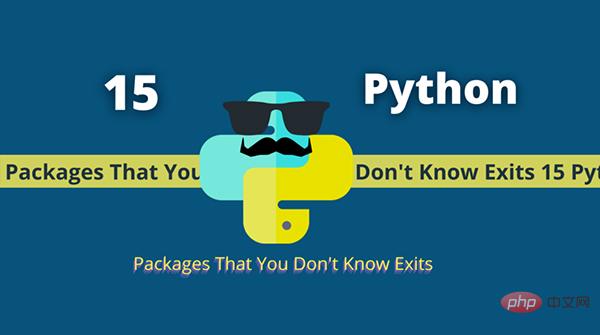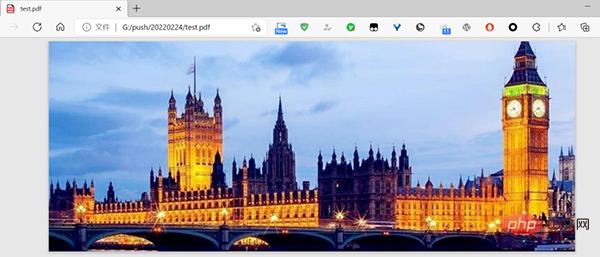 Backend Development
Backend Development
 Python Tutorial
Python Tutorial
 Python implements batch synthesis of images into PDF format
Python implements batch synthesis of images into PDF format
Python implements batch synthesis of images into PDF format

Under macOS system, preview software can easily do this. At the same time, open the image in a preview window and click Export PDF to successfully export. However, Windows systems do not have such convenient software to achieve this. There are many websites for synthesizing PDFs on the Internet, but these websites without exception require uploading PDFs for synthesis, which I personally think is very unsafe.
Therefore, the safest way is to write a Python script ourselves to implement the synthesis function.
1. Preparation
Please choose any of the following methods to enter the command to install dependencies:
1. Windows environment Open Cmd (Start-Run-CMD).
2. MacOS environment Open Terminal (command space and enter Terminal).
3. If you are using VSCode editor or Pycharm, you can directly use the Terminal at the bottom of the interface.
pip install pillow
2. Synthesis principle
Pillow module, that is, PIL: Python Imaging Library is already the de facto standard library for image processing on the Python platform. PIL is very powerful, but the API is very simple and easy to use. With it, we can easily manipulate images and export them to different formats.
Let’s start with a simple example. We will open a picture and save it in pdf format:
from PIL import Image
import os
def convert_img_pdf(filepath, output_path):
"""
转换图片为pdf格式
Args:
filepath (str): 文件路径
output_path (str): 输出路径
"""
output = Image.open(filepath)
output.save(output_path, "pdf", save_all=True)
if __name__ == "__main__":
convert_img_pdf("1.jpeg", "./test.pdf")
Just use a picture to test it:

After running the code, it was successfully converted into a PDF file:

The conversion was completed in just a few lines of code, which is comparable to those that Websites that upload photos to the cloud are much more secure.
3. Combine multiple photos into PDF
With the basic knowledge of converting photos into PDF, it is very simple to understand the following code for combining multiple photos into PDF.
In fact, we use a special parameter append_images of .save:
output.save(pdfFilePath, "pdf", save_all=True, append_images=sources)
By storing the images into a "sources" array, we can easily synthesize these images into PDF middle.
from PIL import Image
import os
def combine_imgs_pdf(folder_path, pdf_file_path):
"""
合成文件夹下的所有图片为pdf
Args:
folder_path (str): 源文件夹
pdf_file_path (str): 输出路径
"""
files = os.listdir(folder_path)
png_files = []
sources = []
for file in files:
if 'png' in file or 'jpg' in file:
png_files.append(folder_path + file)
png_files.sort()
output = Image.open(png_files[0])
png_files.pop(0)
for file in png_files:
png_file = Image.open(file)
if png_file.mode == "RGB":
png_file = png_file.convert("RGB")
sources.append(png_file)
output.save(pdf_file_path, "pdf", save_all=True, append_images=sources)
if __name__ == "__main__":
folder = r"G:证件\"
pdfFile = r"G:证件身份证.pdf"
combine_imgs_pdf(folder, pdfFile)
In this way, as long as you put your ID photos in a folder and run this Python code, it will automatically combine these ID photos into a PDF and output it to the path you specify. Very simple and convenient.

If you are in need, please follow the code and try it! After watching it a hundred times and reading it a thousand times, it’s better to type it yourself!
The above is the detailed content of Python implements batch synthesis of images into PDF format. For more information, please follow other related articles on the PHP Chinese website!

Hot AI Tools

Undresser.AI Undress
AI-powered app for creating realistic nude photos

AI Clothes Remover
Online AI tool for removing clothes from photos.

Undress AI Tool
Undress images for free

Clothoff.io
AI clothes remover

Video Face Swap
Swap faces in any video effortlessly with our completely free AI face swap tool!

Hot Article

Hot Tools

Notepad++7.3.1
Easy-to-use and free code editor

SublimeText3 Chinese version
Chinese version, very easy to use

Zend Studio 13.0.1
Powerful PHP integrated development environment

Dreamweaver CS6
Visual web development tools

SublimeText3 Mac version
God-level code editing software (SublimeText3)

Hot Topics
 1670
1670
 14
14
 1428
1428
 52
52
 1329
1329
 25
25
 1274
1274
 29
29
 1256
1256
 24
24
 PHP and Python: Different Paradigms Explained
Apr 18, 2025 am 12:26 AM
PHP and Python: Different Paradigms Explained
Apr 18, 2025 am 12:26 AM
PHP is mainly procedural programming, but also supports object-oriented programming (OOP); Python supports a variety of paradigms, including OOP, functional and procedural programming. PHP is suitable for web development, and Python is suitable for a variety of applications such as data analysis and machine learning.
 Choosing Between PHP and Python: A Guide
Apr 18, 2025 am 12:24 AM
Choosing Between PHP and Python: A Guide
Apr 18, 2025 am 12:24 AM
PHP is suitable for web development and rapid prototyping, and Python is suitable for data science and machine learning. 1.PHP is used for dynamic web development, with simple syntax and suitable for rapid development. 2. Python has concise syntax, is suitable for multiple fields, and has a strong library ecosystem.
 How to run sublime code python
Apr 16, 2025 am 08:48 AM
How to run sublime code python
Apr 16, 2025 am 08:48 AM
To run Python code in Sublime Text, you need to install the Python plug-in first, then create a .py file and write the code, and finally press Ctrl B to run the code, and the output will be displayed in the console.
 PHP and Python: A Deep Dive into Their History
Apr 18, 2025 am 12:25 AM
PHP and Python: A Deep Dive into Their History
Apr 18, 2025 am 12:25 AM
PHP originated in 1994 and was developed by RasmusLerdorf. It was originally used to track website visitors and gradually evolved into a server-side scripting language and was widely used in web development. Python was developed by Guidovan Rossum in the late 1980s and was first released in 1991. It emphasizes code readability and simplicity, and is suitable for scientific computing, data analysis and other fields.
 Python vs. JavaScript: The Learning Curve and Ease of Use
Apr 16, 2025 am 12:12 AM
Python vs. JavaScript: The Learning Curve and Ease of Use
Apr 16, 2025 am 12:12 AM
Python is more suitable for beginners, with a smooth learning curve and concise syntax; JavaScript is suitable for front-end development, with a steep learning curve and flexible syntax. 1. Python syntax is intuitive and suitable for data science and back-end development. 2. JavaScript is flexible and widely used in front-end and server-side programming.
 Golang vs. Python: Performance and Scalability
Apr 19, 2025 am 12:18 AM
Golang vs. Python: Performance and Scalability
Apr 19, 2025 am 12:18 AM
Golang is better than Python in terms of performance and scalability. 1) Golang's compilation-type characteristics and efficient concurrency model make it perform well in high concurrency scenarios. 2) Python, as an interpreted language, executes slowly, but can optimize performance through tools such as Cython.
 Where to write code in vscode
Apr 15, 2025 pm 09:54 PM
Where to write code in vscode
Apr 15, 2025 pm 09:54 PM
Writing code in Visual Studio Code (VSCode) is simple and easy to use. Just install VSCode, create a project, select a language, create a file, write code, save and run it. The advantages of VSCode include cross-platform, free and open source, powerful features, rich extensions, and lightweight and fast.
 How to run python with notepad
Apr 16, 2025 pm 07:33 PM
How to run python with notepad
Apr 16, 2025 pm 07:33 PM
Running Python code in Notepad requires the Python executable and NppExec plug-in to be installed. After installing Python and adding PATH to it, configure the command "python" and the parameter "{CURRENT_DIRECTORY}{FILE_NAME}" in the NppExec plug-in to run Python code in Notepad through the shortcut key "F6".



